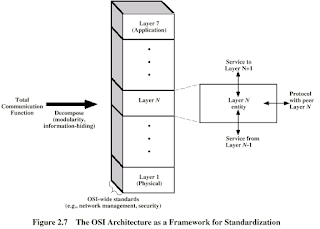The principal motivation for the development of the OSI model was to provide a framework for standardization. Within the model, one or more protocol standards can be developed at each layer. The model defines in general terms the functions to be performed at that layer and facilitates the standards-making process in two ways by allowing standards to be developed independently and simultaneously for each layer, and because changes in standards in one layer need not affect already existing software in another layer.
Stallings DCC8e Figure 2.8 illustrates the use of the OSI model as such a framework. The overall communications function is decomposed into seven distinct layers, making the interfaces between modules as simple as possible. In addition, the design principle of information hiding is used: Lower layers are concerned with greater levels of detail; upper layers are independent of these details. Each layer provides services to the next higher layer and implements a protocol to the peer layer in other systems.

Layer Specific Standards
Stallings DCC8e Figure 2.9 shows more specifically the nature of the standardization required at each layer. Three elements are key:
• Protocol specification: Two entities at the same layer in different systems cooperate and interact by means of a protocol. Because two different open systems are involved, the protocol must be specified precisely. This includes the format of the protocol data units exchanged, the semantics of all fields, and the allowable sequence of PDUs.
• Service definition: In addition to the protocol or protocols that operate at a given layer, standards are needed for the services that each layer provides to the next higher layer. Typically, the definition of services is equivalent to a functional description that defines what services are provided, but not how the services are to be provided.
• Addressing: Each layer provides services to entities at the next higher layer. These entities are referenced by means of a service access point (SAP). Thus, a network service access point (NSAP) indicates a transport entity that is a user of the network service.
